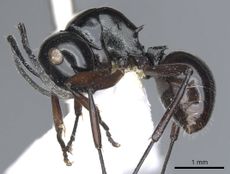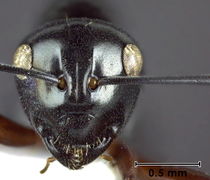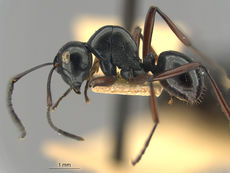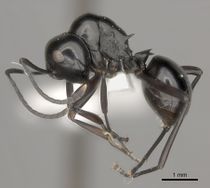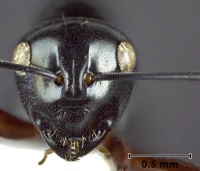Key to Australian Polyrhachis (Cyrtomyrma) species
The following key to Australian Polyrhachis (Cyrtomyrma) species (based on the worker caste) is modified from Kohout (2006[1], 2009[2]).
1
- Pronotal shoulders in dorsal view more-or-less toothed or obtusely angular; greatest width of pronotal dorsum across, or just below shoulders (e.g. Figs 2I, 3G, 4B) => 2
- Pronotal shoulders in dorsal view narrowly or widely rounded; greatest width of pronotal dorsum at, or about, middle of its length (e.g. Figs 2E, 2G, 4D) => 7
2
- Propodeum armed with a pair of spines, denticles or tuberculae (e.g. Figs 2H, 3D, 4A, 4G) => 3
- Propodeum totally unarmed (Fig. 3F) => Polyrhachis robsoni
3
- Dorsal surfaces of body covered with numerous relatively long, mostly erect or variously curved hairs (Fig. 3D) => Polyrhachis monteithi
- Dorsal surfaces of body with only a tuft of erect hairs on summit of mesosoma and a few hairs on dorsum of head and along apical segments of gaster (e.g. Figs 211, 4A) => 4
4
- Propodeal spines well developed, generally longer than half distance between their bases (e.g. Figs 2F-G, 4A-B) => 5
- Propodeal spines much shorter than half distance between their bases or reduced to mere denticles or tuberculae (e.g. Figs 1D-E, 4G-II) => 6
5
- Pronotal shoulders distinctly toothed or bilobed (Fig. 21); generally smaller (HL 1.40-1.47) => Polyrhachis hoelldobleri
- Pronotal shoulders bluntly angular or narrowly rounded (Fig. 4B); generally larger (HL 1.53-1.72) => Polyrhachis australis (in part)
6
- Smaller (HL 1.25-1.34); propodeal spines short, but always present (Fig. 1D-E); legs distinctly yellow, or light reddish-brown => Polyrhachis abbreviata (in part)
- Larger (HL 1.56-1.62); propodeal spines very short or reduced to mere denticles or tuberculae (Fig. 4G-H); legs dark reddish-brown => Polyrhachis yorkana (in part)
7
- Dorsal surfaces of body covered with numerous erect and/or decumbent hairs (e.g. Figs 111, 4E) => 8
- Dorsal surfaces of body virtually without hairs, except for tuft of erect hairs on summit of mesosoma, a few hairs on dorsum of head and along apical segments of gaster (Figs 2D, 4A) => 10
8
- Pubescence of body consisting of abundant, short to very short, somewhat decumbent or recumbent hairs; only a few scattered longer, erect hairs present (Figs 111-I, 311-1) => 9
- Pubescence of body consisting of numerous, relatively long, erect or variously curved hairs, covering most dorsal surfaces; only sparse decumbent hairs present (Fig. 4E-F) => Polyrhachis pilosa
9
- Body distinctly bicoloured, reddish-brown with gaster and appendages bright orange; mesosomal dorsum in lateral view distinctly impressed at promesonotal suture (Fig. 311) => Polyrhachis rutila
- Body unicoloured, jet-black with appendages mostly medium to dark reddish-brown; mesosomal dorsum in lateral view evenly rounded, without distinct impression at promesosonal suture (Fig. 111) => Polyrhachis decumbens
10
- Propodeum armed with a pair of spines, denticles or tuberculae (e.g. Fig. 4A, G) => 11
- Propodeum totally unarmed (e.g. Figs 1F, 2D, 4C) => 14
11
- Mesosomal dorsum in lateral view distinctly flat or shallowly impressed at promesonotal suture (Fig. 2F) => Polyrhachis expressa
- Mesosomal dorsum in lateral view evenly convex, without distinct impression at promesonotal suture (Figs 4A, 4G) => 12
12
- Lateral petiolar spines distinctly longer than dorsal pair; propodeal spines generally longer than half distance between their bases (Fig. 4A-B) => Polyrhachis australis (in part)
- Lateral petiolar spines only slightly longer than dorsal pair, or all spines subequal; propodeal spines shorter than half distance between their bases (e.g. Figs 1D-E, 4G-II) => 13
13
- Propodeal spines short, but always present (Fig. 1D-E); legs distinctly yellow, or light reddish-brown => Polyrhachis abbreviata (in part)
- Propodeal spines very short, present as strongly upturned denticles or more-or-less distinct tuberculae (Fig. 4G); legs dark reddish-brown => Polyrhachis yorkana (in part)
14
- Petiole virtually parallel-sided; petiolar spines very short, lateral spines reduced to denticles (Fig. 1G) => Polyrhachis brevinoda
- Petiole with sides diverging dorsally; lateral petiolar spines at least as long as dorsal pair (Figs 2E, 4D) => 15
15
- Antennal scapes longer (SI >140); lateral petiolar spines distinctly longer than dorsal pair (Indonesia, New Guinea) => Polyrhachis euryala
(not currently known from Australia)
- Antennal scapes shorter (SI <135); lateral and dorsal petiolar spines subequal in length => 16
16
- Pronotum in dorsal view strongly transverse, humeri bluntly angular or narrowly rounded; petiole with sides only weakly diverging dorsally (Fig. 4C-D) (mid- to southern Queensland) => Polyrhachis mackayi
- Pronotum in dorsal view weakly only transverse, humeri widely rounded; petiole with sides more strongly diverging dorsally (Fig. 2D-E) (far north Queensland) => 17
17
- Mesosoma in lateral view more or less evenly rounded with very steep, alomost vertical propodeal declivity (Fig. 2A, D-E) => Polyrhachis delecta
- Mesosoma in lateral view highly arched with anterior face of pronotum steeply rising towards narrow summit; mesonotal and propodeal dorsa steeply descending posteriorly towards oblique declivity (Fig. 5) => Polyrhachis dorowi
References
- ↑ Kohout, R. J. 2006. Review of Polyrhachis (Cyrtomyrma) Forel (Hymenoptera: Formicidae: Formicinae) of Australia, Borneo, New Guinea and the Solomon Islands with descriptions of new species. Memoirs of the Queensland Museum 52:87-146.
- ↑ Kohout, R. J. 2009. A new species and nomenclatural changes in the subgenus Polyrhachis (Cyrtomyrma) Forel. Australian Entomologist 36:37-48.





